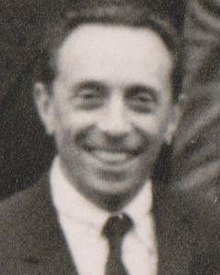Gian-Carlo Wick
Gian-Carlo Wick (born October 15, 1909 in Turin ; † April 20, 1992 ibid) was an Italian physicist who made important contributions to quantum field theory .
Life
His father was a chemical engineer, his mother Barbara Allason (1877–1968) a well-known writer, translator of German literature and an anti-fascist. The paternal grandfather immigrated to Italy from Switzerland. In 1930 he received his diploma (Laurea) in Turin under Gleb Wataghin with a thesis on the electron theory of metals and then went to Göttingen and Leipzig to work with Werner Heisenberg . After another year in Turin, he became Enrico Fermi's assistant in Rome in 1932 . In 1937 he became a professor of theoretical physics in Palermo , then in Padua , before he succeeded Fermis in Rome in 1940 (on his recommendation). In 1946 he followed Fermi to the USA, first to the University of Notre Dame , then to Berkeley . Since he refused the oath required in the McCarthy era (he had already adopted strong liberal views from his mother), he went to the Carnegie Institute of Technology in Pittsburgh in 1951 , where he stayed until 1957, interrupted by stays at the Institute for Advanced Study in Princeton and at CERN near Geneva . In 1957 he became head of the theory department at Brookhaven National Laboratory . In 1965 he became a professor at Columbia University in New York City , where he worked with Tsung-Dao Lee , and after his retirement at the Scuola Normale Superiore in Pisa .
In 1967 he received the Dannie Heineman Prize for Mathematical Physics . In 1968 he received the first Ettore Majorana Prize. He has been a member of the US National Academy of Sciences since 1963 , the American Academy of Arts and Sciences since 1970, and the Accademia dei Lincei since 1994 .
Wick was a passionate mountaineer. He was married twice and had two sons.
plant
As a member of Fermi's group in Rome, he calculated u. a. with group theoretical methods, the magnetic moment of the hydrogen molecule, enhanced Fermi theory of beta decay on the K-capture , wherein he insights from discussions with Ettore Majorana used has particle-antiparticle symmetry, and set one of the first the relationship between the range of forces and the Mass of exchanged bosons. He also worked on the deceleration of neutrons in matter and joined a group of Italian physicists led by Gilberto Bernardini who carried out experiments with cosmic rays near the Matterhorn (including measuring the life span of the muon ). In the USA he made his fundamental contributions to quantum field theory, e.g. B. Wick's theorem 1950, which expresses time-ordered products of operators by normal-ordered ones. In 1952 he worked with Geoffrey Chew on the momentum approximation in scattering theory and introduced super-selection rules and internal parity of elementary particles with Eugene Wigner and Arthur Strong Wightman . The transition from quantum field theory in Minkowski space to Euclidean space through Wick rotation (imaginary in real time) is named after him. He and Maurice Jacob created the helicity formalism to describe the scattering of elementary particles (Jacob-Wick formalism). Other focal points of his work were the meson theory of nuclear forces and the investigation of symmetry principles in physics, u. a. with Tsung-Dao Lee , with whom he also investigated the temperature-dependent vacuum structure of scalar quantum field theories (1971) and theories with indefinite metrics.
literature
- Gian Carlo Wick: About the scattering of neutrons on crystal lattices. In: Physikalische Zeitschrift. Volume 28, 1937, pp. 403, 689
- Gian Carlo Wick: On the range of nuclear forces in Yukawas theory. In: Nature . Volume 142, 1938, p. 99
- Gian Carlo Wick: Evaluation of the collision matrix. In: Physical Review. Volume 80, 1950, p. 268 (Wicks Theorem)
- Gian Carlo Wick: Introduction to some recent work in meson theory. In: Reviews of Modern Physics. Volume 27, 1955, p. 339
- Arthur Strong Wightman, Gian Carlo Wick, Eugene Wigner: Intrinsic parity of elementary particles. In: Physical Review. Volume 88, 1952, p. 101
- Gian Carlo Wick: Invariance principles in nuclear physics. In: Annual Review Nuclear Sciences. Volume 8, 1958, p. 1
- Gian Carlo Wick and Maurice Jacob: On the general theory of collisions of particles with spin. In: Annals of Physics. Volume 7, 1959, p. 404
- Gian Carlo Wick: Group theory, invariance, symmetries. Les Houches Summer School 1965
- Gian Carlo Wick and Tsung-Dao Lee: Vacuum stability and vacuum excitation in spin 0 field theory. In: Physical Review D. Volume 9, 1974, p. 2291
Web links
- Biography of Maurice Jacob in Obituaries National Academy of Sciences
- GC Wick. In: Physics History Network. American Institute of Physics
- Wick, GC - Inspire Author profile
| personal data | |
|---|---|
| SURNAME | Wick, Gian-Carlo |
| BRIEF DESCRIPTION | Italian physicist |
| DATE OF BIRTH | October 15, 1909 |
| PLACE OF BIRTH | Turin |
| DATE OF DEATH | April 20, 1992 |
| Place of death | Turin |
